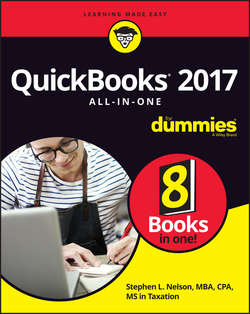Читать книгу QuickBooks 2017 All-In-One For Dummies - Nelson Stephen L. - Страница 13
Book 1
An Accounting Primer
Chapter 2
Double-Entry Bookkeeping
A Few Words about How QuickBooks Works
ОглавлениеBefore I end this chapter, I want to make just a few comments about how QuickBooks helps you. First of all – and this may be the most important point – QuickBooks makes most of these journal entries for you. In Journal Entry 6, for example, I show you how to record a $1,000 check written to pay supplies, but you’d never have to make this journal entry in QuickBooks. When you use QuickBooks to record a $1,000 check that pays Acme Supplies for some paper products that you purchased, QuickBooks automatically debits supplies expense (as long as you indicate that the check is for supplies) and then credits cash.
Similarly, in the case of journal Entries 7 and 8, when you produce an invoice that records a sale, QuickBooks makes these journal entries for you. If you sold $13,000 worth of hot dogs and buns, and those hot dogs and buns actually cost you $3,000, QuickBooks debits cash for $13,000, credits sales revenue for $13,000, debits cost of goods sold for $3,000, and credits inventory for $3,000. In other words, for most of your routine transactions, QuickBooks handles the journal entries for you behind the scenes.
This doesn’t mean, however, that you can always avoid working with journal entries. Any transaction that can’t be handled through a standard QuickBooks form – such as the Invoice form or the Write Checks form – must be recorded by using a journal entry. If you purchase some fixed asset by writing a check, for example, the purchase of the fixed asset gets recorded automatically by QuickBooks. But the depreciation that will be used to expense the asset over its estimated economic life – something I talk a bit about in the next chapter – must be recorded with journal entries that you construct yourself and enter a different way.
One other really important point: I note in the preceding paragraphs that the trial balance information shown in Table 2-19 provides the raw data that you need to prepare your financial statement. I don’t want to leave you with a misunderstanding, however. You don’t actually have to take this sort of raw data and prepare your financial statements. Predictably, QuickBooks easily, quickly, and effortlessly builds your financial statements by using this trial balance information.
Just to put these comments together, then, QuickBooks automatically creates most journal entries for you, builds a trial balance by using journal entry information, and – when asked – produces financial statements. Most of the work of double-entry bookkeeping, then, goes on behind the scenes. You don’t worry about many journal entries on a day-to-day basis. And if you don’t want to ever see a trial balance, you don’t have to. In fact, if you just use QuickBooks to produce invoices and to write checks that pay the bills, almost all the information that you need to prepare your financial statements gets collected automatically. So that’s really neat.
Not all the information that’s necessary for producing good, accurate financial statements gets collected automatically, however. You’ll encounter a handful of important cases that should be handled on a special basis through journal entries that you or your CPA must construct and enter.
